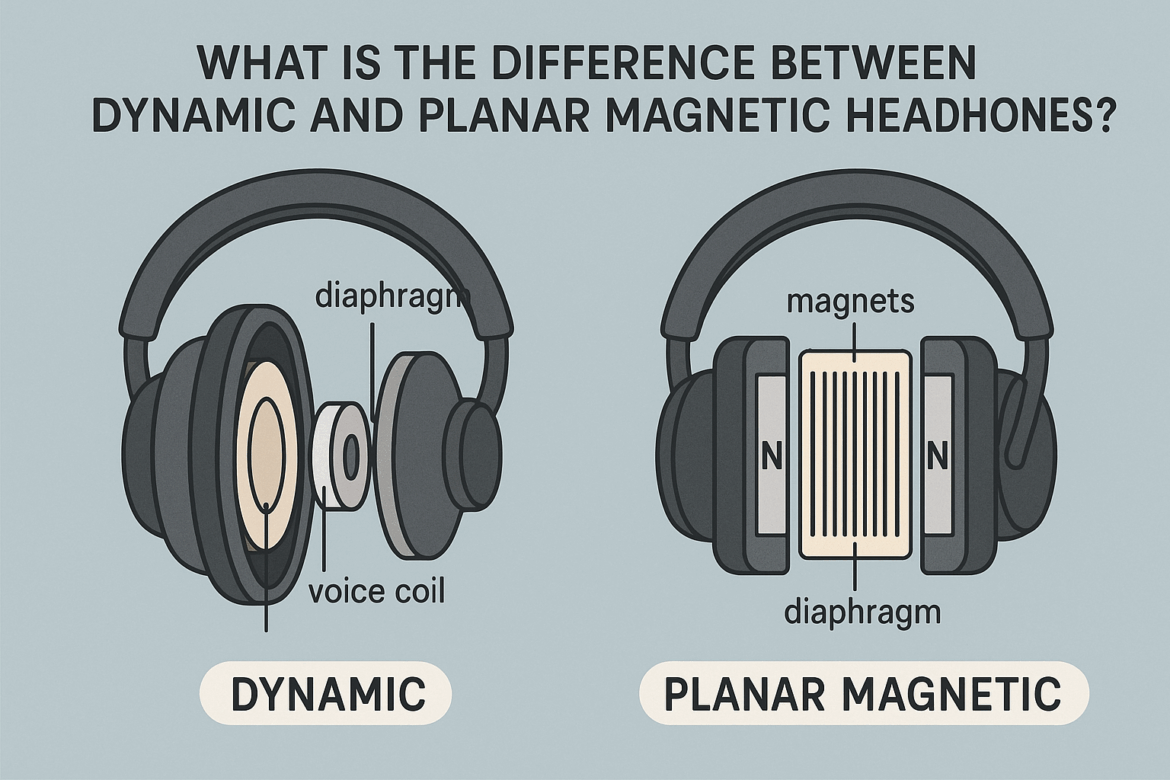Kāda ir atšķirība starp dinamisko un plakano magnētisko Austiņas?
Iztēlojieties sevi pasaulē, kur skaņa nav tikai dzirdama, bet arī jūtama, kur katra nots rezonē ar skaidrību un precizitāti. Šī ir augstas precizitātes audio valstība, un tās centrā ir tikpat sena diskusija kā pati tehnoloģija: izvēle starp dinamiskām un plakanām magnētiskām austiņām. Katra tehnoloģija piešķir skaņas spektram savu unikālo garšu, piedāvājot atšķirīgas priekšrocības un pieredzi prasīgam klausītājam. Dodoties šajā dzirdes ceļojumā, mēs atklāsim noslēpumus, kas slēpjas aiz šiem diviem skaņas titāniem, izpētot to darbības mehānismu, ieguvumus un smalkās nianses, kas tos atšķir.
Dinamisko austiņu izpratne
Dinamiskās austiņas ir audio pasaules stūrakmens, kas pazīstams ar savu spēcīgo veiktspēju un daudzpusību. To pamatā ir vienkāršs, bet efektīvs mehānisms, kas ir izturējis laika pārbaudi.
Dinamisko austiņu mehānika
Dinamiskās austiņas darbojas, izmantojot skaļruni, kas sastāv no trim galvenajām sastāvdaļām: diafragmas, balss spoles un magnēta. Kad elektriskais signāls iziet cauri balss spolei, tas rada magnētisko lauku, kas mijiedarbojas ar magnētu. Šī mijiedarbība izraisa spoles kustību, kas savukārt vibrē diafragmu. Diafragmas vibrācijas rada skaņas viļņus, kas pēc tam tiek piegādāti jūsu ausīm.
Dinamisko austiņu priekšrocības
Dinamiskās austiņas piedāvā vairākas priekšrocības, kas padara tās par iecienītu izvēli gan mūzikas entuziastu, gan ikdienas klausītāju vidū:
-
PieejamībaPateicoties vienkāršākai konstrukcijai, dinamiskās austiņas parasti ir lētākas nekā to plaknes magnētiskās austiņas. Tas padara tās pieejamas plašākam patērētāju lokam.
-
IzturībaDinamisko skaļruņu izturīgais dizains padara tos mazāk uzņēmīgus pret bojājumiem, padarot tos ideāli piemērotus lietošanai kustībā.
-
DaudzpusībaDinamiskās austiņas ir pieejamas dažādos izmēros un konfigurācijās, sākot no pāri ausīm no kompaktiem austiņu modeļiem, kas atbilst dažādām klausīšanās vēlmēm.
-
EfektivitāteTie ir pazīstami ar savu augsto jutību un zemo enerģijas patēriņu, tāpēc tos ir viegli vadīt ar lielāko daļu portatīvo ierīču, piemēram, viedtālruņiem un klēpjdatoriem.
Planāru magnētisko austiņu izpēte
Planārās magnētiskās austiņas, ko bieži uzskata par audiofilu izvēli, piedāvā skaņas reproducēšanas līmeni, kas ir gan ieskaujošs, gan detalizēts. Bet kas tās atšķir no dinamiskajām austiņām?
Plakano magnētisko austiņu mehānika
Plakanās magnētiskās austiņas izmanto atšķirīgu pieeju, izmantojot plānu diafragmu, kas iestrādāta vadoša stieples rakstā. Šī diafragma ir novietota starp diviem magnētu komplektiem. Kad tiek pievadīts elektriskais signāls, diafragma pārvietojas uz priekšu un atpakaļ, reaģējot uz magnētiskajiem laukiem, radot skaņas viļņus.
Planar Magnetic austiņu priekšrocības
Planar magnētiskās austiņas ir pazīstamas ar savu izcilo skaņas kvalitāti un vairākām unikālām priekšrocībām:
-
Skaņas precizitātePlanārie magnētiskie skaļruņi izceļas ar līdzsvarota un precīza skaņas signāla nodrošināšanu, padarot tos ideāli piemērotus kritiskai klausīšanai un studijas lietošanai.
-
Zema kropļošanaVienmērīgs spēka sadalījums pa diafragmu samazina kropļojumus, kā rezultātā audio reproducēšana ir tīrāka un precīzāka.
-
Plaša frekvenču diapazona diapazonsŠīs austiņas bieži piedāvā paplašinātu frekvenču diapazonu, ar ievērojamu skaidrību uztverot gan dziļākos basus, gan vissmalkākās augstās frekvences.
-
Iespaidīga skaņas ainaPlanāras magnētiskās austiņas rada plašu un ieskaujošu skaņas ainu, ļaujot klausītājiem viegli noteikt katra instrumenta atrašanās vietu.
Dinamiskais un plakanais magnētiskais: salīdzinošā analīze
Lai labāk izprastu atšķirības starp dinamiskajām un plakanajām magnētiskajām austiņām, aplūkosim to galveno īpašību salīdzinošo analīzi:
| Funkcija | Dinamiskās austiņas | Planāras magnētiskās austiņas |
|---|---|---|
| Cenu diapazons | Parasti pieejamāki | Parasti dārgāk |
| Izturība | Ļoti izturīgs | Nepieciešama rūpīga apiešanās |
| Skaņas kvalitāte | Labi, ar atšķirībām dažādos modeļos | Augsta precizitāte un detaļas |
| Efektivitāte | Augsts, viegli vadāms | Zemāks, var būt nepieciešama pastiprināšana |
| Frekvenču diapazons | Plaši atšķiras | Plašs un precīzs |
| Skaņu skatuve | Mērens | Plašs un ieskaujošs |
| Izmērs un svars | Mainīgs, bieži vien vieglāks | Parasti lielāks un smagāks |
Apsvērumi, izvēloties starp abiem
Izvēloties starp dinamiskām un plakanām magnētiskām austiņām, jāņem vērā vairāki faktori, katrs no kuriem ietekmē jūsu klausīšanās pieredzi un dzīvesveidu.
Paredzētais lietojums
Apsveriet, kā un kur plānojat izmantot austiņas. Ja meklējat pārnēsājamu risinājumu braukšanai uz darbu vai ceļošanai, dinamiskās austiņas varētu būt labāka izvēle to izturības un efektivitātes dēļ. No otras puses, ja esat dedzīgs audiofils vai profesionālis, kam nepieciešama precīza skaņas reproducēšana, plaknes magnētiskās austiņas varētu būt ieguldījuma vērtas.
Budžeta ierobežojumi
Budžets bieži vien ir būtisks faktors, izvēloties starp šiem diviem austiņu veidiem. Dinamiskās austiņas piedāvā lielisku veiktspējas un pieejamības līdzsvaru, savukārt plakanās magnētiskās austiņas, lai arī dārgākas, nodrošina nepārspējamu skaņas kvalitāti tiem, kas ir gatavi ieguldīt līdzekļus.
Skaņas preferences
Arī jūsu personīgajām skaņas preferencēm ir izšķiroša nozīme. Dinamiskās austiņas var piedāvāt spēcīgu, ar basiem bagātu skaņu, kas patīk daudziem, savukārt plaknes magnētiskās austiņas nodrošina neitrālāku un precīzāku audio pieredzi, atklājot jūsu iecienītāko dziesmu smalkās nianses.
Secinājums: Izvēle ir jūsu ziņā
Galu galā izvēle starp dinamiskajām un plakanajām magnētiskajām austiņām ir ļoti personiska, ko nosaka jūsu individuālās vajadzības, vēlmes un budžets. Abas tehnoloģijas piedāvā kaut ko unikālu, bagātinot jūsu dzirdes pieredzi savā atšķirīgā veidā. Dinamiskās austiņas piedāvā pieejamību un daudzpusību, savukārt plakanās magnētiskās austiņas nodrošina nepārspējamu precizitāti un dziļumu.
Uzsākot savu skaņas ceļojumu, atcerieties, ka pareizās austiņas nav tikai instruments, bet gan vārti uz skaņas pasauli, kas var pārveidot jūsu mūzikas baudīšanas veidu. Neatkarīgi no tā, vai izvēlaties dinamisko austiņu spēcīgo uzticamību vai plakano magnētisko austiņu izsmalcināto detaļu, viena lieta ir skaidra: mūzika nekad vairs neskanēs tāpat kā agrāk.
Pēdējoreiz atjaunināts 2025. gada 26. augustā
